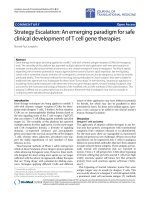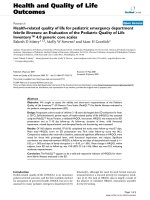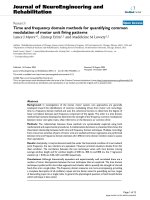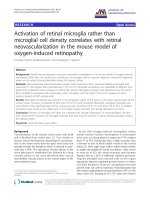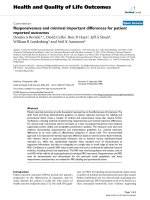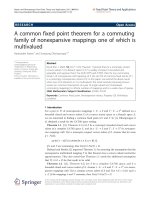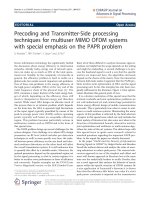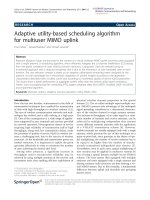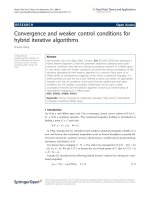Báo cáo hóa học: " Precoding and Transmitter-Side processing techniques for multiuser MIMO OFDM systems with special emphasis on the PAPR problem" pdf
Bạn đang xem bản rút gọn của tài liệu. Xem và tải ngay bản đầy đủ của tài liệu tại đây (123 KB, 2 trang )
EDI T O R I A L Open Access
Precoding and Transmitter-Side processing
techniques for multiuser MIMO OFDM systems
with special emphasis on the PAPR problem
G Wunder
1*
, RFH Fischer
2
, S Litsyn
3
and JS No
4
Green information technology has significantly fuelled
the discussion about energy efficiency in information
networks. Already today, energy cost of network opera-
tion can make up as much as 50% of the t otal opera-
tional cost. Notably, by the complexity of networks in
general, the efficiency problem is hard to tackle on a
global scale but entails several important sub-problems.
One of these sub-problems is the energy efficiency of
the high-power amplifier (HPA) at the very end of the
radio frequency chain o f the physical layer [1]. The
HPA consumes a major fraction of the total energy bud-
get of which, depending on the efficiency class, still
much is dissipated as thermal energy and therefore
wasted. While smart HPA design can alleviate much of
this process there is an intrinsic problem which depends
on the form how the HPA is operated: high fluctuations
of the input signal–typically quantified by means of the
peak-to-average power ratio (PAPR)–enforce operating
points typically well below an acceptable efficiency
region. This problem becomes particularly serious in
multicarrier systems such as OFDM and is the focus of
this special issue.
The PAPR problem brings up several challenges for the
system designer. One challenge is to adjust HPA design
parameters on RF level (which includes pre-distortion
techniques as well) in some spec ific way: here, the trade-
off between power efficiency on the one hand and toler-
ated nonlinear distortions on the other hand will affect
the overall transmission system. It is still unknown how
to quantify this effect by a suitable metric. Moreover, the
optimal parameters depend on the operational regime set
by the signal processing, so that in certain regimes it is
better to sacrifice error performance in favor of efficiency
and conversely. Popular examples are the EVM (Error
Vector Magnitude) metric or the SER (Symbol Error
Rate) all of them difficult to analyze; Gaussian approxi-
mations are helpful but the scope depends on the setting
and might be misleading. A second challenge is to pro-
cess the baseband signal in such a way that the specific
metrics are improved: here, the algorithms obviously
depend on the choice of the metric. Now, the interaction
between both tasks makes it apparent that the PAPR pro-
blem involves joint optimization of HPA and the signal
processing unit. So far, this i nterplay has only been mar-
ginally addressed in the literatu re. Figure 1: Joint optimi-
zation illustrates this general point of view.
It is a decisive motivation of this special issue that the
intrinsic tradeoffs and joint optimization problems are
not well understood yet and contain huge potential for
future energy efficient design of mobile communication
networks. This is particularly true when it comes to mul-
tiuser or multi-antenna systems. Illuminating the many
aspects of this problem is reflected by the final selection
of papers in this special issue which not only includes the
latest update of literature but also some new ideas in the
direction of fundamental bounds, alternative metrics,
joint optimization and multiuser or multi-antenna algo-
rithms for state-of-the-art systems. The editors hope with
this special issue to ignite more research related to
unsolved questions regarding the important PAPR pro-
blem. In the sequel the papers are shortly discussed:
In the paper “PAPR and the Density of Information
Bearing Signals in OFDM“ by Holger Boche and Brendan
Farrell the authors discuss and analyze the value of reser-
ving subcarriers to reduce peak power. The reserved sub-
carriers approach is one of the simplest and oldest and
most well-known approach in literature but at the same
time one the analytically hardest to tackle. Hereby, they
use a novel approach that analyzes the behavior of metric
spaces within the specific structure of OFDM systems. By
a nice application of Szemerédi’s theorem it is shown
then that the efficiency fall s below any value if a strict
peak power constraint is imposed on the transmission
* Correspondence:
1
Heinrich-Hertz-Institut Berlin, Berlin, Germany
Full list of author information is available at the end of the article
Wunder et al. EURASIP Journal on Advances in Signal Processing 2011, 2011:59
/>© 2011 Wunder et al; licensee Springer. This is an Open Access article dis tributed under the terms of the Creative Commons
Attribution Lice nse ( .0), which permits unrestri cted use, distribution, and reproduction in
any medium, provided the original work is properly ci ted.
regardless where the reserved subcarriers are placed.
Clearly, these results establish also fundamental bounds
on the potential gains due to coding for the PAPR
problem.
The analysis of an alternative metric instead of PAPR is
the topic of the paper “ On the EVM Computation of
Arbitrary Clipped Multi-Carrier Signals“ by Igal Kotzer
and Simon Litsyn. The authors provide exact analytical
results for computing the EVM metric circumventing the
common Gaussian approximation. The approach uses a
novel Fourier representation and power series method to
calculate the average distortion energy and it is general
enough to capture other HPA models than the standard
soft clipping model. The EVM metric is used for evalua-
tion in the paper “Power amplifier linearization technique
with IQ imbalance and crosstalk compensation for broad-
band MIMO OFDM transmitters“ by Fernando Gregorio,
Juan E. Cousseau, Stefan Werner, Taneli Riiho nen, and
Risto Wichman where a stochastic control algorithm is
devised for a novel joint crosstalk, IQ imbalance and
nonlinear amplifier response compensation of a MIMO
OFDM transmitter. The authors design a MIMO pre-dis-
tortion scheme using a parallel nonlinear model based on
memory polynomials where the coefficients are con-
stantly adapted by the underlying control algorithm.
Multiuser downlink systems with multiple antennas are
covered in the paper “Selected Basis for PAR Reduction in
Multi-User Downlink Scenarios using Lattice-Reduction-
Aided Precoding“ by Christian Siegl and Robert Fischer
where nonlinear Tomlinson-Harashima-type pre-coding
is combined with basis selection algorithm for PAPR
reduction. Similarly, in the multiuser MIMO OFDM
uplink with DFT pre-coding, the joint problem of maxi-
mum throughput and PAPR reduction is tackled in the
paper “Sum rate optimization by spatial precoding for a
Multiuser MIMO DFT-precoded OFDM uplink“ by Hang-
uang Wu, Thomas Haustein, Eduard Jorswieck, and Peter
Hoeher. Here, the idea is to maintain and optimize a fre-
quency non-se lective spatial filter in the inner MIMO
OFDM system which preserves the excellent PAPR prop-
erties of DFT pre-coded OFDM. Adapting the spatial fil-
ter is also considered in “Peak-to-Average-Power-Ratio
(PAPR) Reduction in WiMAX and OFDM/A Systems“ by
Seyran Khademi, Thomas Svantesson, Mats Viberg, and
T. Eriksson. Here, a novel approach to finding phase
shifts within context of PTS technique is presented.
Space-time-frequency block coded system are analyzed
for PAPR reduction in “PAPR Reduction in SFBC MIMO
MC-CDMA Systems via User Reservation“ by Mariano
Garcia Otero and Luis A. Paredes-Hernandez as well as
“Low PAPR space frequency block coding for multiuser
MIMO SC-FDMA systems: Specific issues for users with dif-
ferent spectral al locations“ by Cristina Ciochina, David
Mottier, and Damien Castelain. In the first paper a MC-
CDMA system is addressed where potentially signals of
inactive users are added for the benefit of PAPR reduction.
In the second paper a DFT pre-coded MIMO OFDM
architecture is addressed where a novel space-frequency
mapping scheme is devised and analyzed which differs
from the standard Alamouti scheme while it preserves low
PAPR.
Author details
1
Heinrich-Hertz-Institut Berlin, Berlin, Germany
2
Universität Ulm, Ulm,
Germany
3
Tel Aviv University, Tel Aviv, Israel
4
Seoul National University,
Seoul, Korea
Received: 24 August 2011 Accepted: 17 September 2011
Published: 17 September 2011
Reference
1. LM Correia, D Zeller, O Blume, D Ferling, Y Jading, I Gdor, G Auer, L Van der
Perre, “Challenges and enabling technologies for energy aware mobile
radio networks,”. IEEE Signal Processing Magazine. 48(11), 66–72
(November 2010)
doi:10.1186/1687-6180-2011-59
Cite this article as: Wunder et al .: Precoding and Transmitter-Side
processing techniques for multiuser MIMO OFDM systems with special
emphasis on the PAPR problem. EURASIP Journal on Advances in Signal
Processing 2011 2011:59.
Operational regime
Optimization
Design &
Key figures of merit
HPA
Predistortion
Design &
Optimization
unit
Signal processing
Figure 1 Joint optimization of RF and signal processing.
Wunder et al. EURASIP Journal on Advances in Signal Processing 2011, 2011:59
/>Page 2 of 2
